The Relevance of GLAS/ICESat Elevation Data for the Monitoring of River Networks
Abstract
:1. Introduction
2. Lake Leman
2.1. Description of Study Site and Dataset
Study Site
Dataset
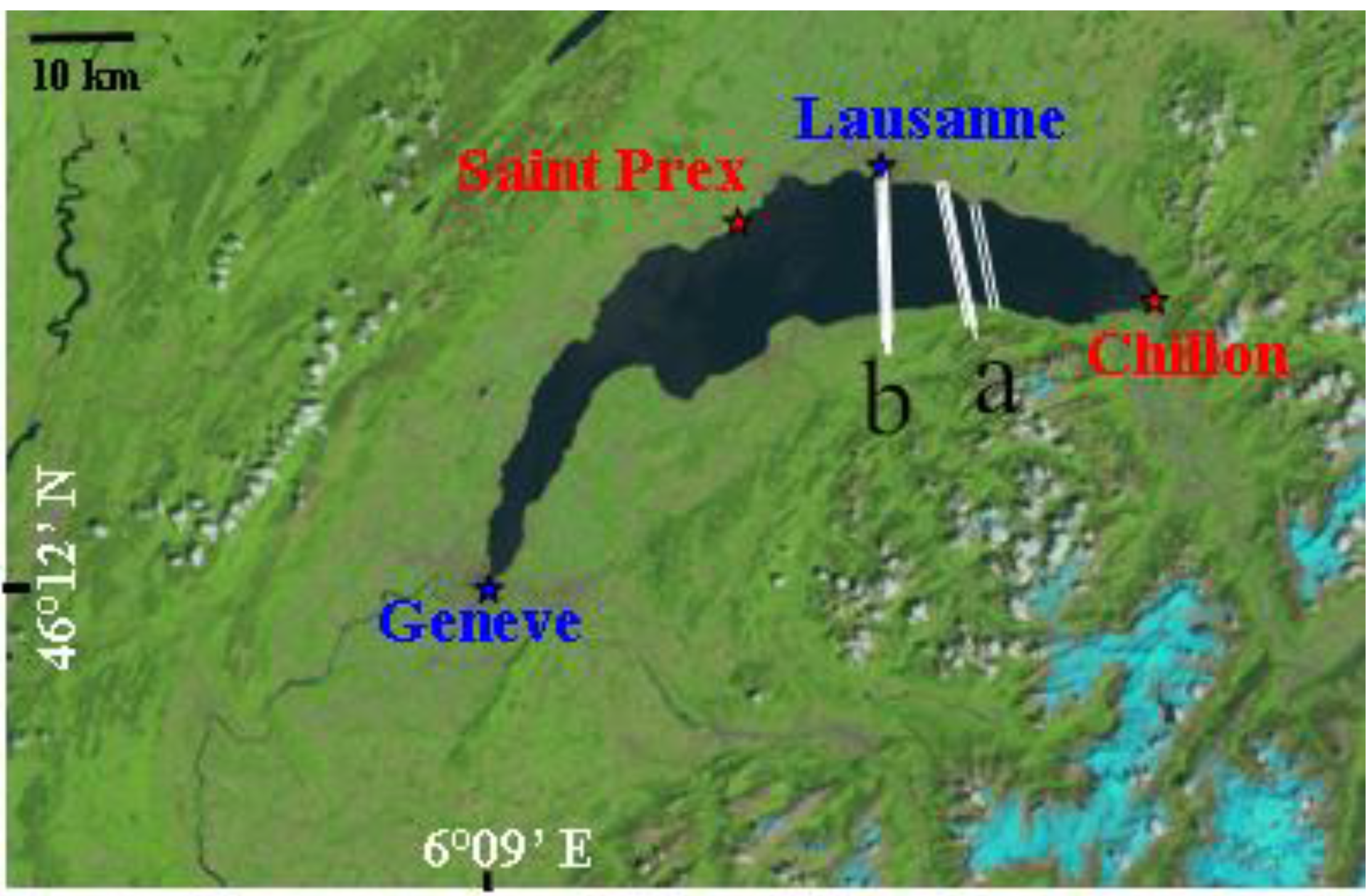
2.2. Results
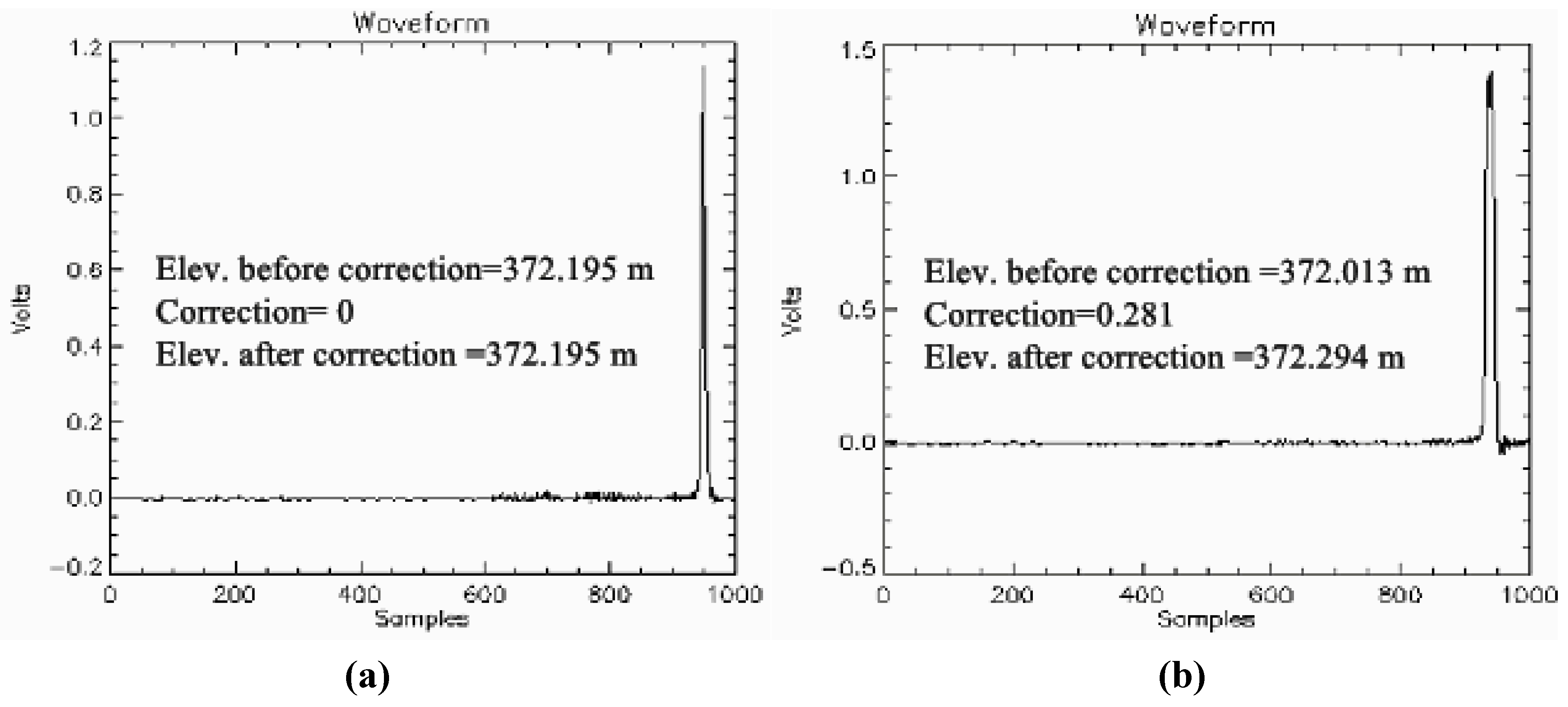
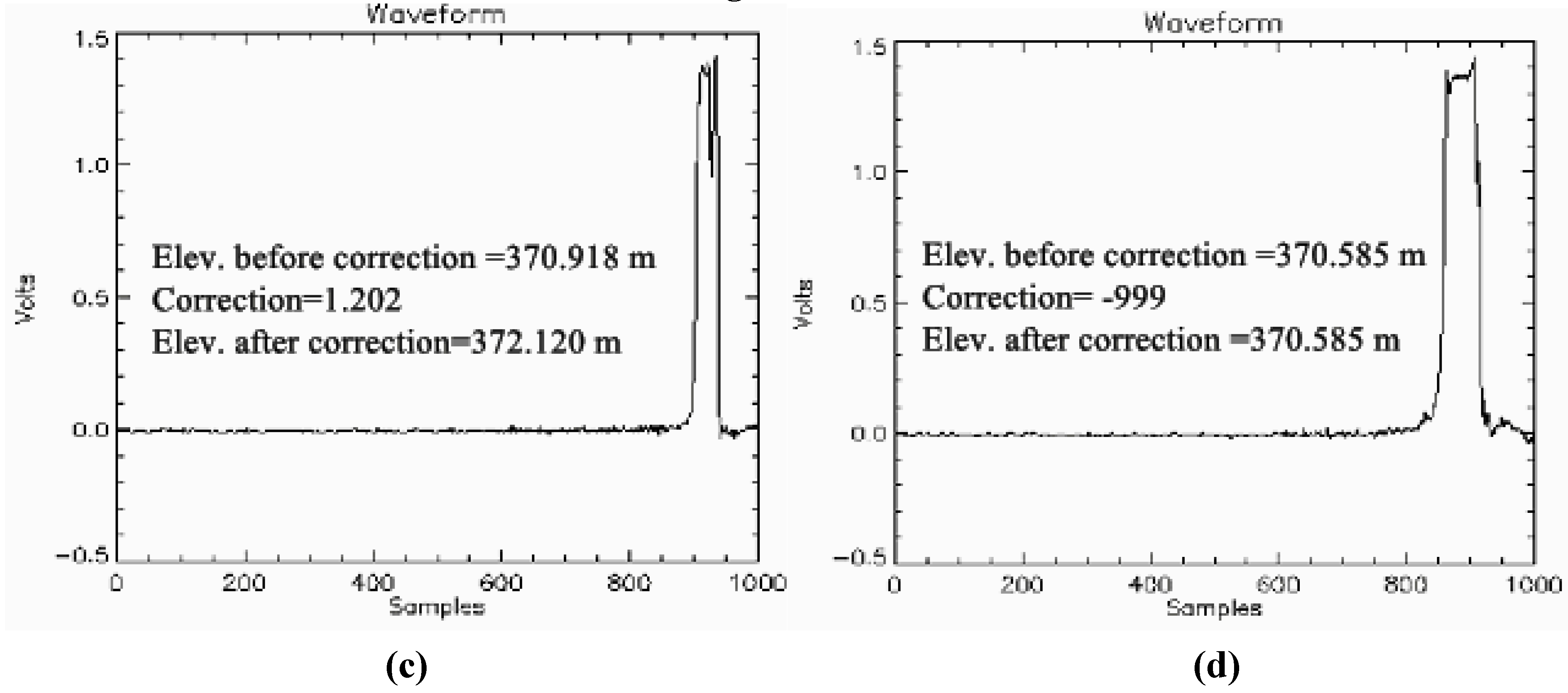
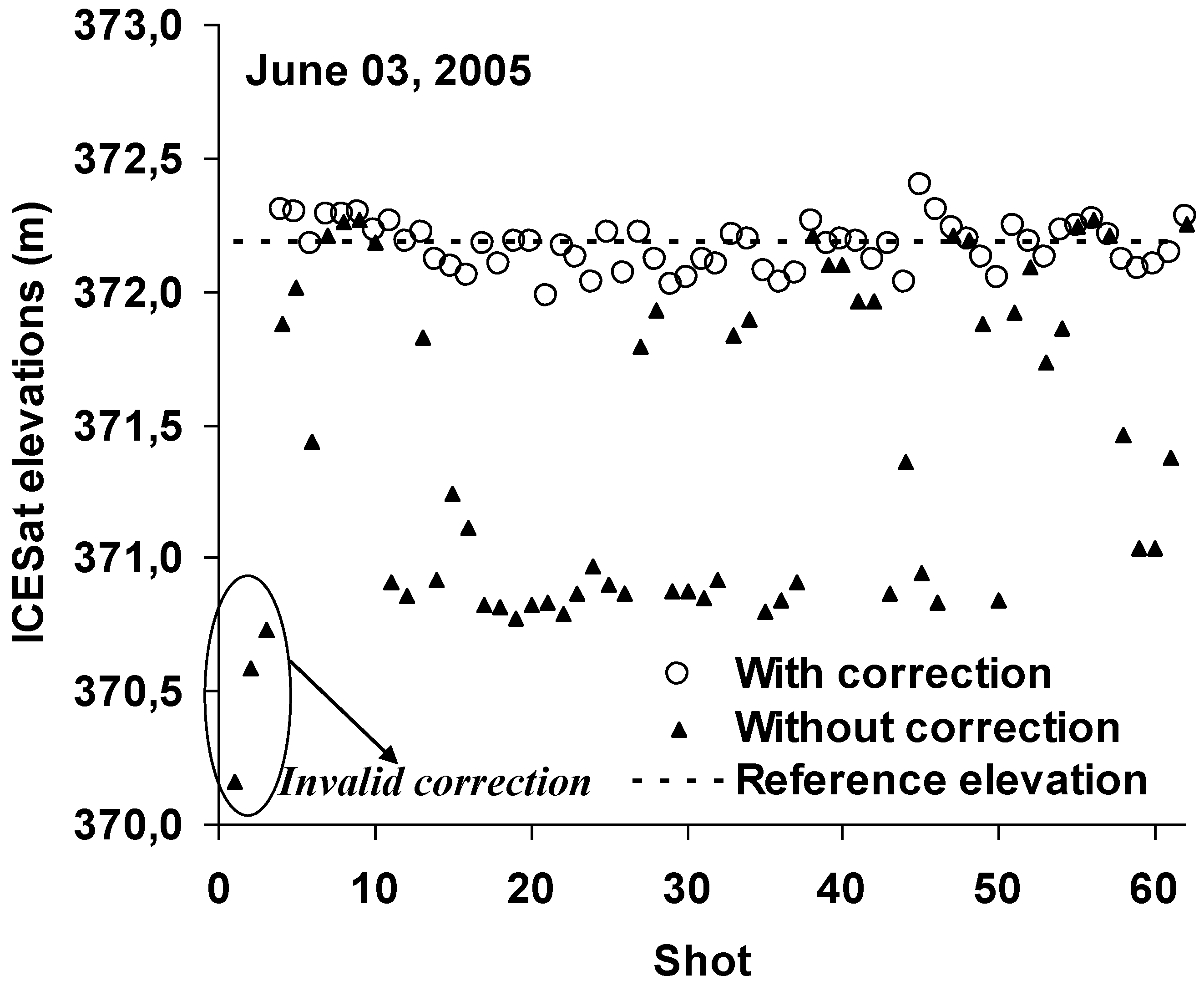
- ➢
- Category 1: Shots corresponding to land. The saturation correction is valid (between 0 and 1.50 m).
- ➢
- Category 2: Three to eight shots correspond to “land”, “land+water” or “water” with invalid correction.
- ➢
- Category 3: Two to ten shots correspond to “water” with valid correction, but not adapted (called transition shots).
- ➢
- Category 4: ICESat shots corresponding to “water” with estimated elevations close to reference elevations. The saturation correction is valid and well adapted.
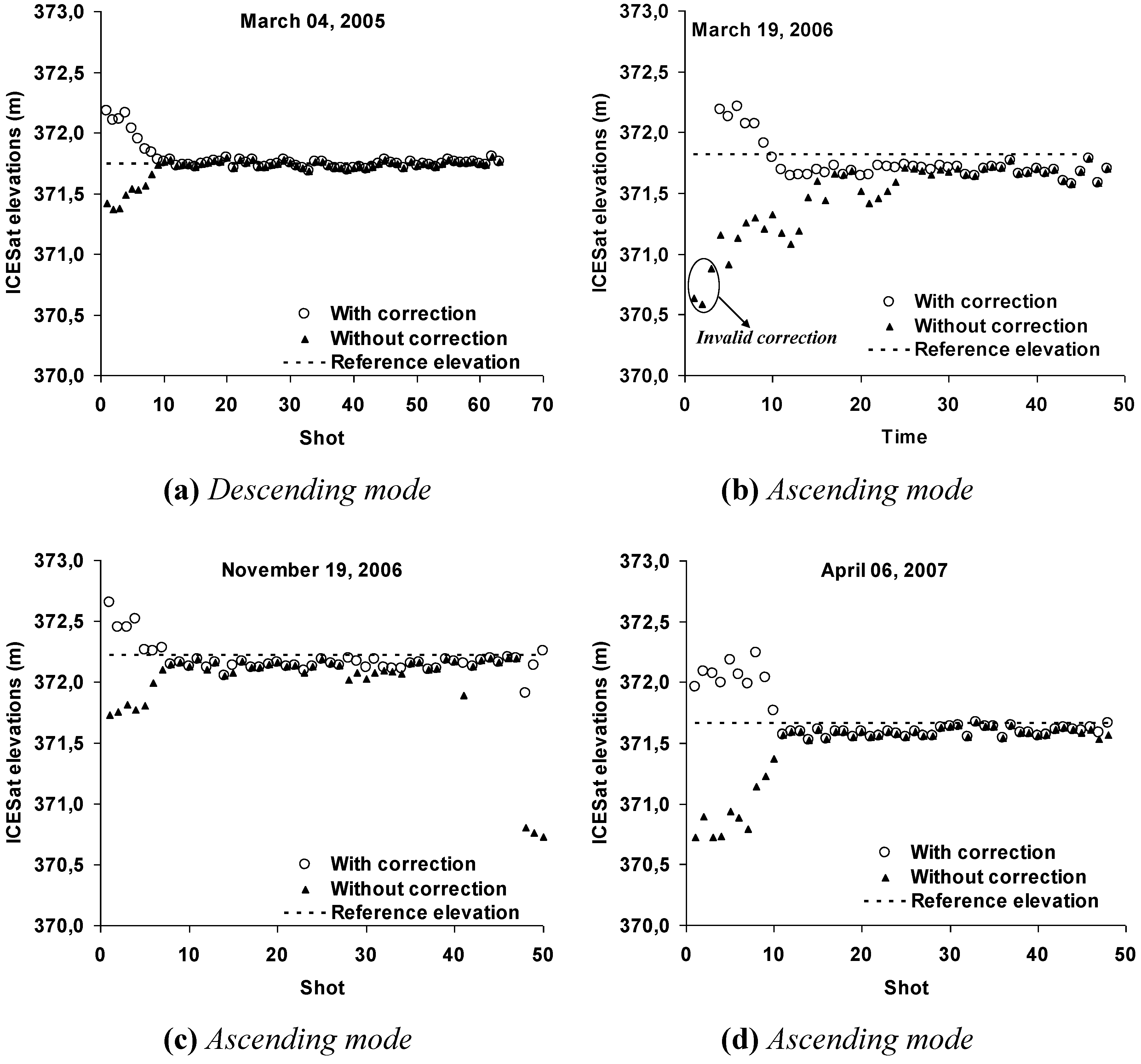
| Date | Hydrological gauges | ICESAT Dataset | ICESat elevation (m) Without correction | ICESat elevation (m) With correction | ||||||
|---|---|---|---|---|---|---|---|---|---|---|
| dd/mm/yy | Reference elevation (m) | Shot number | mean | std | RMSE | ICESat-Ref | mean | std | RMSE | ICESat-Ref |
| 02/03/04 * | 371.72 | 60 | 371.72 | 0.05 | 0.05 | 0.00 | 371.72 | 0.05 | 0.05 | 0.00 |
| 12/06/04 * | 372.23 | 47 | 372.19 | 0.11 | 0.11 | −0.04 | 372.24 | 0.12 | 0.12 | 0.01 |
| 04/03/05 * | 371.74 | 61 | 371.78 | 0.11 | 0.12 | 0.04 | 371.71 | 0.09 | 0.09 | −0.03 |
| 16/03/05 | 371.68 | 42 | 370.59 | 0.50 | 1.19 | −1.09 | 371.77 | 0.16 | 0.18 | 0.09 |
| 03/06/05 | 372.18 | 61 | 371.49 | 0.59 | 0.90 | −0.69 | 372.14 | 0.09 | 0.10 | −0.04 |
| 15/11/05 * | 372.25 | 49 | 371.99 | 0.10 | 0.27 | −0.25 | 372.05 | 0.13 | 0.23 | −0.19 |
| 19/03/06 | 371.82 | 43 | 371.53 | 0.22 | 0.36 | −0.29 | 371.74 | 0.15 | 0.17 | −0,08 |
| 07/06/06 * | 372.17 | 63 | 372.24 | 0.07 | 0.10 | 0.07 | 372.26 | 0.08 | 0.12 | 0.09 |
| 18/06/06 | 372.26 | 45 | 372.19 | 0.21 | 0.22 | −0.07 | 372.42 | 0.11 | 0.19 | 0.16 |
| 07/11/06 * | 372.22 | 63 | 372.23 | 0.13 | 0.13 | 0.01 | 372.29 | 0.08 | 0.11 | 0.07 |
| 19/11/06 | 372.22 | 50 | 372.00 | 0.34 | 0.40 | −0.22 | 372.18 | 0.12 | 0.13 | −0.04 |
| 25/03/07 * | 371.74 | 61 | 371.81 | 0.10 | 0.12 | 0.07 | 371.87 | 0.07 | 0.15 | 0.13 |
| 06/04/07 | 371.66 | 48 | 371.45 | 0.28 | 0.35 | −0.21 | 371.69 | 0.19 | 0.19 | 0.03 |
| 16/10/07 | 372.21 | 59 | 372.02 | 0.24 | 0.30 | −0.19 | 372.20 | 0.07 | 0.07 | −0.01 |
| 13/03/08 * | 371.53 | 22 | 371.31 | 0.21 | 0.30 | −0.22 | 371.31 | 0.21 | 0.30 | −0.22 |
3. Rivers of Metropolitan France
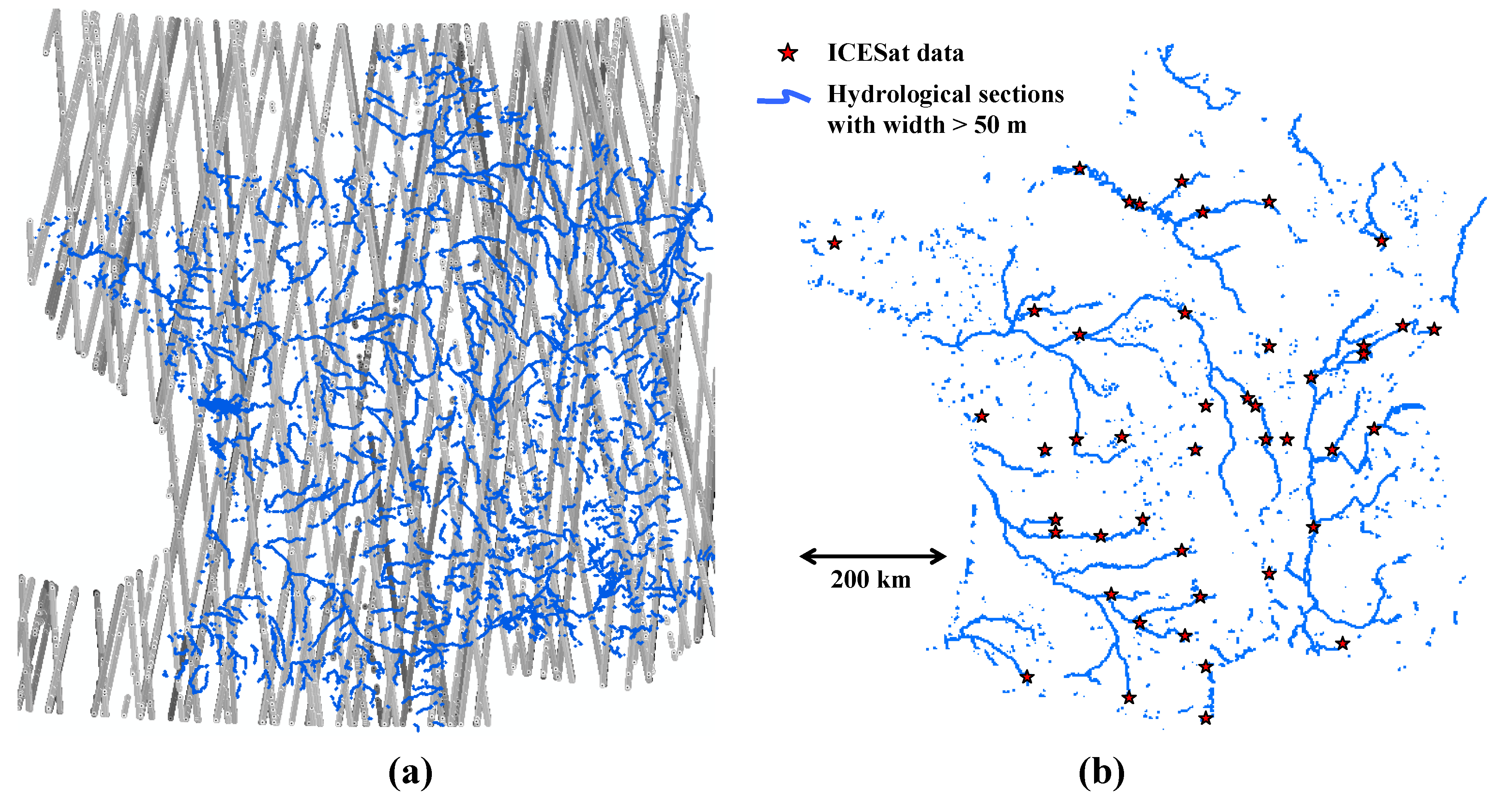
| Laser campaign | Start date (dd/mm/yyyy) | End date (dd/mm/yyyy) |
|---|---|---|
| L3A | 10/03/2004 | 11/08/2004 |
| L3B | 02/17/2005 | 03/24/2005 |
| L3C | 05/20/2005 | 06/23/2005 |
| L3D | 10/21/2005 | 11/24/2005 |
| L3E | 02/22/2006 | 03/28/2006 |
| L3F | 05/24/2006 | 06/26/2006 |
| L3G | 10/25/2006 | 11/27/2006 |
| L3H | 03/12/2007 | 04/14/2007 |
| L3I | 10/02/2007 | 11/05/2007 |
| L3J | 02/17/2008 | 03/21/2008 |
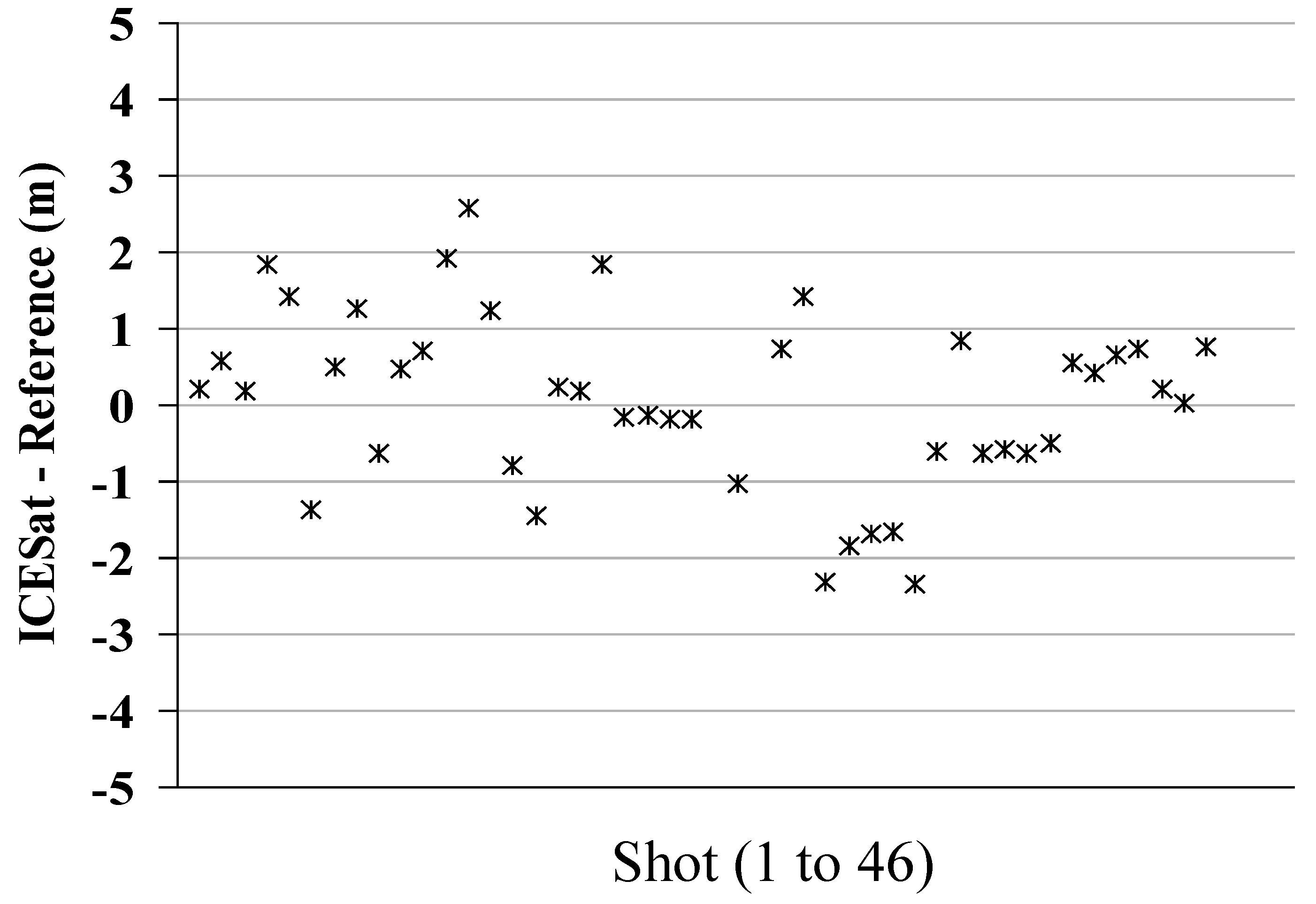
4. Conclusions
Acknowledgements
References
- Calmant, S.; Seyler, F. Continental surface waters from satellite altimetry. Comptes Rendus Geosciences 2006, 338, 1113–1122. [Google Scholar]
- Hui, F.; Xu, B.; Huang, H.; Yu, Q.; Gong, P. Modelling spatial-temporal change of Poyang Lake using multitemporal Landsat imagery. Int. J. Remote. Sens. 2008, 29, 5767–5784. [Google Scholar] [CrossRef]
- Andreoli, R.; Yesou, H.; Li, J.; Desnos, Y.L. Inland Lake Monitoring Using Low and Medium Resolution ENVISAT ASAR and Optical Data: Case Study of Poyang Lake (Jiangxi, PR China). In Proceedings of 2007 IEEE International Geoscience and Remote Sensing Symposium, Barcelona, Spain, 23–28 July 2007; pp. 4578–4581.
- Koblinsky, C.J.; Clarke, R.T.; Brenner, A.C.; Frey, H. Measurement of river level variations with satellite altimetry. Water Resour. Res. 1993, 29, 1839–1848. [Google Scholar] [CrossRef]
- Birkett, C.M.; Mertes, L.A.K.; Dunne, T.; Costa, M.; Jasinski, J. Surface water dynamics in the Amazon Basin: Application of satellite radar altimetry. J. Geophys. Res. 2002, 107, 1–21. [Google Scholar] [CrossRef]
- Coe, M.T.; Birkett, C.M. Calculation of river discharge and prediction of lake height from satellite radar altimetry: Example for the Lake Chad basin. Water Resour. Res. 2004, 40, 1–11. [Google Scholar] [CrossRef]
- Morris, C.S.; Gil, S.K. Evaluation of the TOPEX/Poseidon altimeter system over the Great lakes. J. Geophys. Res. 1994, 99, 24527–24539. [Google Scholar] [CrossRef]
- Birkett, C.M. Synergistic remote sensing of Lake Chad: Variability of basin inundation. Remote. Sens. Environ. 2000, 72, 218–236. [Google Scholar] [CrossRef]
- Crétaux, J.F.; Birkett, C. Lake studies from satellite radar altimetry. Comptes Rendus Geosciences 2006, 338, 1098–1112. [Google Scholar] [CrossRef]
- Schutz, B.; Zwally, H.; Shuman, C.; Hancock, D.; Dimarzio, J. Overview of the ICESat mission. Geophys. Res. Lett. 2005, 32, L21S01. [Google Scholar] [CrossRef]
- Zwally, H.J.; Schutz, B.; Abdalati, W.; Abshire, J.; Bentley, C.; Brenner, A.; Bufton, J.; Dezio, J.; Hancock, D.; Harding, D.; Herring, T.; Minster, B.; Quinn, K.; Palm, S.; Spinhirne, J.; Thomas, R. ICESat’s laser measurements of Polar ice, atmosphere, ocean and land. J. Geodynamics 2002, 34, 405–445. [Google Scholar] [CrossRef]
- Urban, T.J.; Schutz, B.E.; Neuenschwander, A.L. A survey of ICESat coastal altimetry applications: Continental coast, open ocean island, and inland river. Terr. Atmos. Ocean. Sci. 2008, 19, 1–19. [Google Scholar] [CrossRef]
- Chipman, J.W.; Lillesand, T.M. Satellite-based assessment of the dynamics of new lakes in southern Egypt. Int. J. Remote. Sens. 2007, 28, 4365–4379. [Google Scholar] [CrossRef]
- Bhang, K.J.; Schwartz, F.W.; Braun, A. Verification of the vertical error in C-band SRTM DEM using ICESat and Landsat-7, Otter Tail County, MN. IEEE Trans. Geosci. Remote Sens. 2007, 45, 36–44. [Google Scholar] [CrossRef]
- Martin, C.F.; Thomas, R.H.; Krabill, W.B.; Manizade, S.S. ICESat range and mounting bias estimation over precisely-surveyed terrain. Geophys. Res. Lett. 2005, 32, L21S07. [Google Scholar] [CrossRef]
- Braun, A.; Cheng, K.; Csatho, B.; Shum, C.K. ICESat Laser Altimetry in the Great Lakes. In Proceedings of the 60th Annual Meeting of the Institute of Navigation, Dayton, OH, USA, 7–9 June 2004.
- Federal Office for the Environment (FOEN). Hydrological Data. Available online: http://www.hydrodaten.admin.ch/e/index.htm (accessed on 1 April 2011).
- Abshire, J.B.; Sun, X.L.; Riris, H.; Sirota, J.M.; McGarry, J.F.; Palm, S.; Yi, D.; Liiva, P. Geoscience Laser Altimeter System (GLAS) on the ICESat mission: On-orbit measurement performance. Geophys. Res. Lett. 2005, 32, L21S07. [Google Scholar] [CrossRef]
- Pereira-Cardenal, S.J.; Riegels, N.D.; Berry, P.A.M.; Smith, R.G.; Yakovlev, A.; Siegfried, T.U.; Bauer-Gottwein, P. Real-time remote sensing driven river basin modeling using radar altimetry. Hydrol. Earth Syst. Sci. 2011, 15, 241–254. [Google Scholar] [CrossRef]
- Schumann, G.; Bates, P.; Horritt, M.; Matgen, P.; Pappenberger, F. Progress in integration of remote sensing-derived flood extent and stage data and hydraulic models. Rev. Geophys. 2009, 47, RG4001. [Google Scholar] [CrossRef]
- Straatsma, M.; Huthoff, F. The Effect of Uncertain Floodplain Roughness in Hydrodynamic Flood Simulations. In Proceedings of the 10th International Symposium on Stochastic Hydraulics, Quebec City, QC, Canada, 1–10 July 2010.
- Alsdorf, D.E.; Rodrguez, E.; Lettenmaier, D.P. Measuring surface water from space. Rev. Geophys. 2007, 45, RG2002. [Google Scholar] [CrossRef]
© 2011 by the authors; licensee MDPI, Basel, Switzerland. This article is an open access article distributed under the terms and conditions of the Creative Commons Attribution license (http://creativecommons.org/licenses/by/3.0/).
Share and Cite
Baghdadi, N.; Lemarquand, N.; Abdallah, H.; Bailly, J.S. The Relevance of GLAS/ICESat Elevation Data for the Monitoring of River Networks. Remote Sens. 2011, 3, 708-720. https://doi.org/10.3390/rs3040708
Baghdadi N, Lemarquand N, Abdallah H, Bailly JS. The Relevance of GLAS/ICESat Elevation Data for the Monitoring of River Networks. Remote Sensing. 2011; 3(4):708-720. https://doi.org/10.3390/rs3040708
Chicago/Turabian StyleBaghdadi, Nicolas, Nicolas Lemarquand, Hani Abdallah, and Jean Stéphane Bailly. 2011. "The Relevance of GLAS/ICESat Elevation Data for the Monitoring of River Networks" Remote Sensing 3, no. 4: 708-720. https://doi.org/10.3390/rs3040708
APA StyleBaghdadi, N., Lemarquand, N., Abdallah, H., & Bailly, J. S. (2011). The Relevance of GLAS/ICESat Elevation Data for the Monitoring of River Networks. Remote Sensing, 3(4), 708-720. https://doi.org/10.3390/rs3040708






